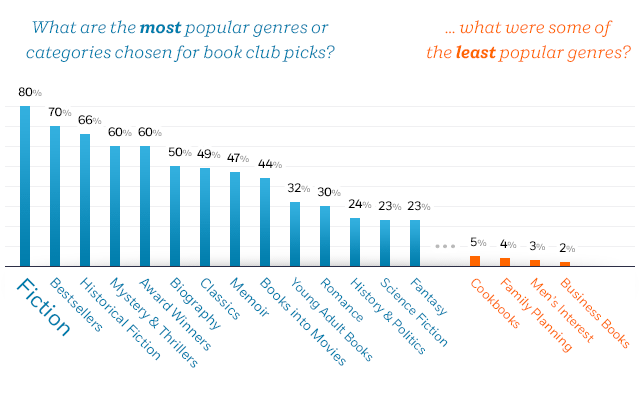Millions of Americans take part in book clubs every month, in their own living rooms and via ever-expanding forms of social media. Read on to find out how the landscape of book clubs has changed, and how authors can engage with them.
Book Clubs and New Media
Traditionally, spaces for book clubs have ranged from private living rooms to libraries, bookstores, and other public venues where readers can connect to discuss a particular book. With the rise of social media, book clubs are showing up in new formats and places.
Online social platforms and other forms of new media have become spaces for readers to connect. From Facebook and Instagram to book-specific apps like Litsy and Reco, many readers are turning to the Internet to interact with other readers. Penguin Random House has a number of reader- and book-club-focused online communities, including Random House Reader’s Circle, the Reading Group Center, and Read it Forward. Book clubs are also cropping up as podcasts (here is a good roundup of a few); in newsletters, including a partnership between Penguin Young Readers Group and the Clover newsletter; as part of subscription boxes like Book of the Month and Quarterly; and even as live shows.
In late 2015, Vogue magazine proposed that Instagram is “the new Oprah’s Book Club.” Celebrities with large followings on the popular social media platform—among them actor and producer Reese Witherspoon, lifestyle guru Gwyneth Paltrow, comedian Mindy Kaling, and social media influencer Eva Chen—began brandishing their favorite new reads in Instagram posts. These posts easily reach many thousands of followers, encourage informal book discussions in comments sections, and have in some cases boosted online sales of particular titles. Two influencers even parlayed their appreciation of books and reading into their own literary imprints: Lena Dunham, in partnership with Jenni Konner, launched the Lenny imprint at Random House as an extension of the popular email newsletter Lenny Letter; and Sarah Jessica Parker, who has long been an advocate for books— even going so far as to have book club brainstorming sessions with publishing teams—is launching the eponymous SJP imprint under Hogarth, part of Crown Books.
In addition to Instagram, celebrities have encouraged book club discussion in online forums via the website Goodreads. Actor and activist Emma Watson launched her online feminist book club “Our Shared Shelf” via Goodreads in January 2016. To date, the group has more than 144,000 members, and has done online Q&A sessions with several authors, including Caitlin Moran and Carrie Brownstein. And, of course, the original Oprah’s Book Club is very much still an active and influential entity.
What Does the Data Show Us?
What can we glean from all this? People want to engage with others who are reading the same book, and there are more places than ever to do it. Do all of these apps and platforms mean that book clubs comprise a younger, more tech-savvy audience?
Last year, Penguin Random House conducted a survey of more than 3,000 people from the Reader Advisory Panel. This group is an audience of passionate readers, so the data is skewed in terms of how many of those surveyed participate in book clubs (63 percent). However, the survey still tells us quite a bit about the reading habits and structure of book clubs, and about the people in them.
Note: This survey was conducted in such a way that for some questions, participants could select as many options as they liked. So the percentages don’t always sum to 100 percent, but instead indicate what percentage of the total survey size selected a given option as being true of their book club.
What influences book selection?
- 71% Familiarity with author
- 67% (A) friend(s) recommended it
- 49% Interest in a particular topic/theme
- 47% People will be talking about it
- 47% Recent bestseller
What formats do book clubs read/listen to?
- 82% Hardcover
- 90% Paperback
- 61% Ebook
- 22% Audiobook
Other interesting things mined from the data:
- 72% said that reviews available online were important.
- 29% of those surveyed meet with their book clubs monthly.
- 57% use Goodreads to select books.
- 80% enjoyed “most” of the books their book club reads.
- 57% said they would not otherwise read “some” of the books selected by their book club.
How Can Authors Engage with Book Clubs?
What should you take away from this data? For one thing, book clubs are not “one size fits all.” They vary when it comes to age, taste, background, and even preference for format.
Authors can engage with book clubs in a number of ways. Structured spaces, like libraries and book stores, may host in-person book club discussions. There are also online spaces through which authors can engage, like the Mashable “MashReads” social book club. If you use Goodreads, then turn on the “Ask the Author” feature to open your page up to a Q&A with readers. And, of course, authors can leverage their own Facebook, Instagram, and Twitter accounts in innovative ways to engage with readers online.
You can also work with your editorial and marketing teams to create reading group guides for your books. Even if these guides are not included in the back of the physical or digital edition of a book, they can be posted to your website. Some marketing teams have also found success by working with authors to create other supplementary material for author websites: a recipe related to the book’s content, a recommended book list for further reading, additional information about the historical people or places featured in a book.
The added content creates a reading experience, and the possibilities are endless!
Casey Blue James is Manager, Business Development, at Penguin Publishing Group, a division of Penguin Random House.



